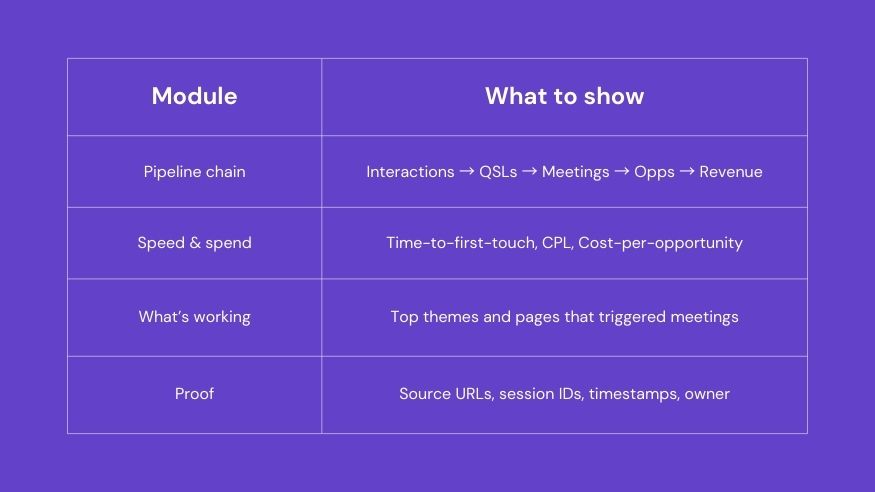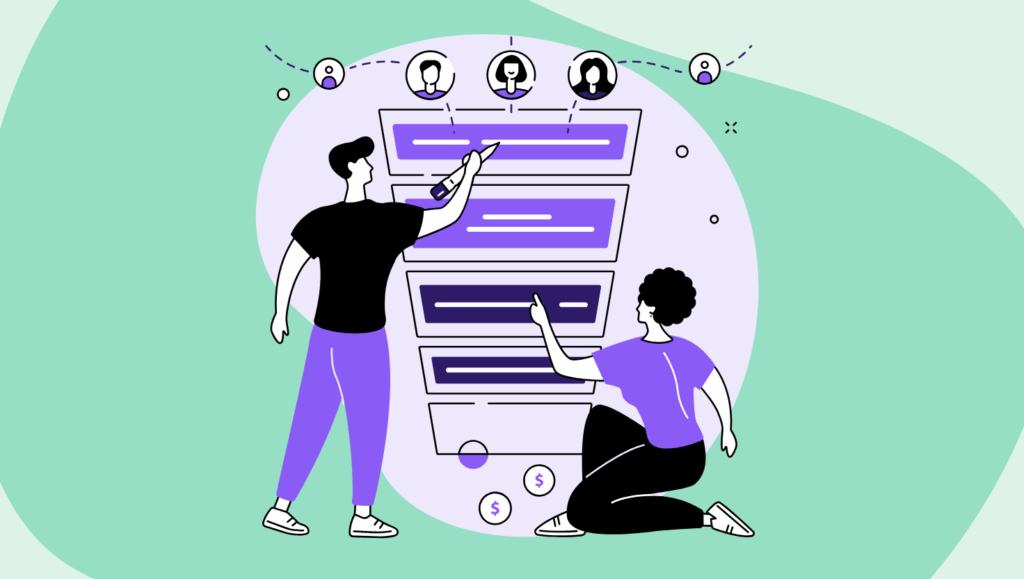Sponsor ROI, Finally Counted: Turning Session Engagement into Pipeline
You don’t buy sponsorships for vanity. You buy them for pipeline. Yet most post-event reports stop at badge scans and booth anecdotes, useful trivia, weak proof. This playbook turns live session behaviour, poll votes, Q&A taps, and resource clicks into qualified sponsor leads, booked meetings, and attributed revenue you can defend in a renewal call.
It’s written for commercial leaders seeking a straightforward, repeatable method to capture first-party intent, accelerate progress, and demonstrate the results. Along the way, you’ll see short notes from two real programs, Terrapinn and Informa, so your team can point to what’s worked in the field.
Step 0: Agree on the scorecard (before the event)
Do this
Set targets for: Qualified Sponsor Leads (QSLs), Meetings, Opportunities, Sourced Pipeline ($), Time-to-first-touch, Cost-per-opportunity, and Renewal uplift. Report by session theme, sponsor tier, and named accounts.
Why it matters
When sponsors see meetings and opportunities tied to the sessions they funded, negotiations shift from opinion to numbers.
Bridged case study note
Informa ran a self-serve dashboard for quick edits and A/B tests, eliminating the backlog and enabling faster reporting to sponsors.
Step 1: Capture the right signals (during sessions)
Do this
Label interactions at the session level: topic + session + mapped sponsor. Treat repeat Q&A on buying themes, pricing/resource clicks, and ≥15-minute watch time with a booth scan as high signal. Keep consent + UTMs tight so remarketing stays clean.
Why it matters
Not every click shows intent. Give weight to actions that predict meetings.
Bridged case study note
Terrapinn spun up multiple event agents quickly, answered attendee questions reliably, and nudged people to approved pages, great inputs for post-session scoring. Informa used interactive polling and timely offers to collect high-quality first-party data, not just noise.
Step 2: Stream data into CRM/MAP
Do this
Pipe app and site events straight into your CRM/MAP with timestamps and standard fields: interaction type, session, theme, sponsor, and user ID.
Why it matters
Speed wins. You can’t book meetings if the data’s stuck in exports.
Bridged case study note
Informa wired agents to lead management and content systems, enabling teams to test and personalize without waiting on engineering.
Step 3: Score & route with a Qualification Agent
Do this
Score = ICP fit + recency + depth. Dedupe, assign an owner, and fire SLA alerts so first touch happens inside 24 hours.

Why it matters
Sponsors feel the difference between “we noticed you” and “we’re here with the exact help you asked for.”
Bridged case study note
Terrapinn’s agents covered almost every question and guided users to high-value pages, perfect for high-confidence scoring.
Step 4: Personalize & activate with an advertiser ad on agent
Do this
Assemble sponsor-ready emails and micro-pages from the attendee’s interaction trail. Sync high-signal audiences to ad platforms, no manual exports.
Why it matters
Personalization tied to the session and theme that triggered interest lifts meeting rates without adding headcount.
Bridged case study note
Informa’s offer placements boosted clicks and lead gen by surfacing premium content at the right moment.
Step 5: Follow up on a clock (T+1h, T+24h, T+72h)
Do this
- T+1h: “You asked…” email with the exact answer, one relevant resource, and a direct calendar link.
- T+24h: sponsor-branded invite tailored to the option they picked in the poll.
- T+72h: precision ads to non-responders from consented audiences.
Why it matters
Interest fades fast. Treat these timings like SLAs, not nice-to-haves.
Bridged case study note
Terrapinn’s no-code setup meant teams could adjust plays instantly without waiting on a release cycle.
Step 6: Report the chain sponsors pay for
Do this
Show the full path: Interaction → QSL → Meeting → Opportunity → Revenue. Cut by session theme, sponsor tier, and named account lists. Include owner, time-to-first-touch, and source URL for each meeting/opportunity line.
Why it matters
This is the renewal story. It proves which content and themes actually moved deals.
Bridged case study note
Informa drove more leads without higher spend, grew first-party data, and multiplied survey completions, clear evidence that interaction → lead → revenue is achievable.Terrapinn saw strong CTR to agendas, speakers, and registration from agent answers, solid leading indicators for sponsor action.
Step 7: Keep it fair across tiers
Do this
Use a topic-to-sponsor matrix with tie-breaks: tier + named accounts; if both apply, split by last-touch time. Audit quarterly.
Why it matters
Prevents “who owns this lead” battles and keeps partners happy.
30-day rollout (copy this)

Bridged case study note
Terrapinn replicated this setup across events without losing quality.
Informa’s self-serve dashboard let GTM teams tweak quickly and keep momentum.
What sponsors see each week

Ready-to-use follow-ups
T+1h “You asked”
Subject: Your question, answered, plus a shortcut
Body: “You tapped three pricing questions in {Session Title}. Here’s the short answer, a 2-page explainer, and {Rep Name}’s calendar if you want to go deeper.”
T+24h invite
Subject: 20 minutes on {Theme} this week?
Body: “Since you chose the ‘{Theme}’ poll option, we lined up an engineer to walk you through the exact setup you asked about.”
Sponsors don’t renew based on scans; instead, they renew based on meetings, opportunities, and pipeline they can trace back to the sessions they funded. This playbook provides a clear path from live engagement to revenue, guiding you through capturing the right signals, wiring the data, scoring and routing with urgency, following up on a clock, and reporting the full chain by theme. Terrapinn’s speed and quality show you can deploy this without chaos. Informa’s lift in leads and first-party data shows you can scale it without extra spend.
If you lock the scorecard this week and run the T+1h / T+24h / T+72h cadence at your next event, your sponsor update won’t be a recap; it’ll be a pipeline report with names, meetings, and next steps.
Putting It All Together
Picture a relay race: the baton is intent. Poll votes, Q&A taps, content clicks, that’s the runner leaving the block. Your job? Make sure the baton hits the sponsor’s hand before the track ends. Capture fast, score smart, route fairly, and keep the scoreboard (your dashboard) visible. Do this, and ROI stops being a debate and starts being a graph sponsors love.
FAQs
Q. What’s a simple event attribution model we can start with?
A. Use linear session-level attribution. Give primary credit to the intent-carrying session that triggered the first sponsor response. Keep it simple for renewals; go granular only when a sponsor requests it.
Q. Can we stay privacy-safe and still retarget?
A. Yes. Build audiences from consented registrants and attendees, then run cookieless retargeting for events via platform integrations. You don’t need third-party cookies to keep sponsors visible.
Q. How do you prove event sponsorship ROI without relying on badge scans? –
A. Follow an event attribution model that ties interaction → qualified lead → meeting → opportunity → revenue.
Q.Which interactions are the strongest event intent signals?
A. Repeated Q&A taps on buying topics, long session dwell plus booth scan, and pricing-themed resource clicks. Score them higher and push to same-day SLAs to create meeting-ready leads from events.
Q. Are micro-events worth it for B2B prospecting?
A. Yes, community and networking events outperform large trade shows for prospecting. Use them to feed named-account programs.
Q. What’s a simple event attribution model we can start with?
A. Use linear session-level attribution. Give primary credit to the intent-carrying session that triggered the first sponsor response. Keep it simple for renewals; go granular only when a sponsor requests it.
Q. Can I retarget attendees without third-party cookies?
A. Yes. Build permissioned audiences from registrants and attendees and run cookieless retargeting for events through your MAP/ad platforms, anchored on consented email or MAID where allowed.
Q. What event benchmarks should I share with sponsors this quarter?
A. Meetings, opportunities, sourced pipeline from events, time-to-first-touch, and cost-per-opportunity.


